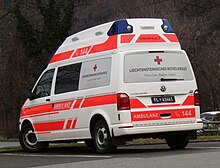Liechtenstein Red Cross
| Liechtenstein Red Cross (LRK) |
|
|---|---|

|
|
| legal form | non-profit association |
| founding | April 30, 1945 |
| founder | Gina von Liechtenstein (initiative) |
| Seat | Vaduz , Liechtenstein |
| main emphasis | Humanitarian aid , international humanitarian law , social work |
| people | Sophie von Liechtenstein , President |
| Employees | 21st |
| Members | approx. 1000 (2017) |
| Website | www.roteskreuz.li |
The Liechtenstein Red Cross (LRK) is the National Red Cross Society in the Principality of Liechtenstein according to the Geneva Agreement and as such part of the International Red Cross and Red Crescent Movement with its headquarters in Geneva . Today the LRK is the largest aid organization in the country.
The LRK has around 1000 members (2017). This corresponds to about 2.7% of the population.
history
The Liechtenstein Red Cross was founded on April 30, 1945 on the initiative of Gina von Liechtenstein . In cooperation with the International Committee of the Red Cross (ICRC) and the International Federation of Red Cross and Red Crescent Societies, it aims to fulfill humanitarian tasks in accordance with the principles of the Red Cross and thus places itself at the service of needy and needy people, without Reputation of nationality, race, belief, gender, social position or political conviction.
Presidents
- Gina von Liechtenstein (1945–1985)
- Marie Aglaë from and to Liechtenstein (1985-2015)
- Sophie von Liechtenstein (since 2015)
organization
The legal form is a non-profit association and is therefore organized accordingly.
Aid organizations
The LRK's aid organizations are the Samaritan associations in the communities (Vaduz, founded 1951; Schaan, founded 1952; Liechtensteiner Unterland, founded 1954; Balzers, founded 1961; Triesenberg, founded 1968; Triesen, founded 1972).
Service areas
The best-known service area of the Liechtenstein Red Cross is the rescue service , as it is with this that the LRK is the most prominent. The Liechtenstein Red Cross also has a department for mother and father counseling and the Gamander children's home in Schaan.
Ambulance service
Since 1955, the LRK has been offering ambulance service transport across the whole of Liechtenstein. The first vehicle was made possible thanks to a private donation. Since 1971 there has been an ambulance service in the narrower sense, which started its work on January 2, 1972 with four full-time paramedics and volunteers from the Samaritan associations as well as two rescue vehicles. Since April 2017 there are two teams for different tasks. The first team is available around the clock for emergencies such as traffic accidents, sports accidents, medical emergencies, assistance in the event of illness and accidents, etc. The second team carries out predictable secondary transports upon request, including a. Transport on deck, relocations, transports for special diagnostic examinations in medical centers, etc. belong. Over 90% of the rescue service transports are carried out by the LRK itself, the rest by partners.
The term rescue service describes services of emergency rescue and ambulance transport. Emergency rescue is also divided into medical emergency rescue ( emergency doctor , provided by the Liechtenstein State Hospital) and non-medical emergency rescue. The tasks in emergency rescue are the supply, care and transport of emergency patients . Ambulance transports are divided into qualified and simple ambulance transports. The tasks in ambulance transport are the supply, care and transport of patients (no emergency patients!).
The emergency number 144 for alerting the rescue service has been housed in a joint operations center at the state police since October 2017. Before that, the emergency call was coordinated via the coordination office of the Liechtenstein State Hospital.
The costs for the rescue service are borne by contributions from the state, reimbursements for services from health insurers and insurance companies, and private donations. An annual Christmas card campaign is also carried out for the benefit of the emergency services.
Between 1,400 and 1,500 rescue services are carried out annually (an average of 4 rescue services per day).
Security at events
The LRK also offers ambulance services through the local Samaritan associations especially for events . Depending on the size of the event, a corresponding number of paramedics and medical service facilities will be made available for this.
Blood donation service
The blood donation services in Liechtenstein (blood donation campaigns) are carried out in the individual communities by the Liechtenstein Samaritan Associations (summarized in the Liechtenstein Samaritan Association - VLS) in cooperation with the Austrian Red Cross .
further services
The Liechtenstein Red Cross opened a home for children in a small family house in Triesen in 1956. This home serves to support families with whom children cannot live with their families for a shorter or longer period of time. The children's home was moved to Schaan in 1965 (Gamander children's home). For years, children from war and crisis areas have been invited and looked after at the Gamander Children's Home.
A so-called mother's advice service had existed since November 1, 1946, nowadays called Mothers and Fathers Advice (MVB). Telephone counseling for parents, home calls and discussions at the counseling centers in the communities for children in the first years of life are currently offered (in 2016, 1,549 consultations and 189 home calls as well as 990 e-mail and telephone consultations were carried out).
See also
literature
- Elke Endraß: The benefactor. Why Henry Dunant founded the Red Cross. Wichern Verlag, Berlin 2010, ISBN 3-88981-288-0 .
Web links
- Official website
- Association of Liechtenstein Samaritan Associations (VLS).
- Joachim Batliner: Liechtenstein Red Cross (LRK). In: Historical Lexicon of the Principality of Liechtenstein .
Individual evidence
- ↑ ANNUAL REPORT 2016 . In 2016: 1015 members.
- ↑ LRK: Annual Report 2016 (PDF) Retrieved on October 3, 2017 .
- ^ LRK: Annual Report 2016. Retrieved on October 3, 2017 .
- ^ LRK: Annual Report 2016. Retrieved on October 3, 2017 .
- ^ LRK: Donating blood. Retrieved October 3, 2017 .
- ↑ Annual report 2016, p. 48.

